St Withburga
Arum, Fairy Lamps and the ever-lasting spring: the legend of the Anglo Saxon St Withburga.
24/07/13 /09:06 Category: Timeline

One of the more religious mentions of Arum is the plant’s association with St Withburga. Withburga was the youngest of four daughters of the Anglo-Saxon king Anna. When he died in 654, his eldest daughter Ethelreda inherited the Isle of Ely and founded the monastery and abbey there. Withburga meanwhile founded a nunnery and church at Dereham in Norfolk. Typically (for a fairy-tale type of legend) she was the poorest of the four sisters and during the building of her nunnery she did not have enough money to buy food for the workmen. After praying for divine intervention, two young does appeared from the surrounding woodland and allowed her maids to milk them. This sustained the workmen in their labours until a jealous local landowner chased the does away with his hunting dogs.
Tradition does not say whether this was after the church was completed or before and if before, we know not how the poor workmen continue to be fed. Tradition does record though that the landowner’s experience of divine retribution was swift, for shortly afterwards he was thrown from his horse and broke his neck.
No further miracles are recorded until long after Withburga died and had been buried in her church. Fifty years passed without event, until her body was discovered to be as fresh as when it was first interred. She is even reported to have blushed when a workman caressed her face with his finger. At this point, events take a dramatic turn.
News of the saint’s undecaying body spread quickly and the little church surrounding her fresh remains became a popular destination for the pious. This didn’t go down terribly well with the increasingly powerful Bishop of Ely and in 974 he ordered that Withburga’s body be forcibly removed and brought to Ely, ostensibly so that she could rest alongside her sisters who were all buried there. Another reason is thought to be so that the Bishop could enjoy the prestige and profit to be made from the increasing numbers of pilgrims journeying to visit St Withburga’s miraculously undecaying body. The Bishop of Ely’s monks arrived at the church with a cover story of wanting to celebrate St Withburga’s presence and miraculous preservation. They plied the locals with food and drink. And more drink. And more still. When everyone had fallen into a drunken stupor (but having somehow kept themselves sober), they stole the body of St Withburga and proceeded to take her back to Ely. Part of the journey was along the river Little Ouse. Richard Mabey, in his book Flora Britannica, includes a tale from E.M. Porter’s Cambridgeshire Customs and Folklore (1969) that describes the part played by Arum in this drama. The monks from Ely rested at Brandon, whereupon nuns from the nearby convent at Thetford arrived and covered the body of the saint in Arum ‘flowers’ (possibly due to an at the time recognised symbolism with death?). As the boat moved on, these fell from the body and took root in the river banks. Eventually the banks were covered in Arum blossoms that glowed with a pale, white light along the entire length of the river from Thetford to Ely. Meanwhile, back at Dereham, a spring had appeared where Withburga’s body had lain. This flows still to this day and has never run dry.
From this legend come the Cambridgeshire names for Arum of Fairy Lamps and Shiners, from how the flowers glow at night. Another name is River Fairy Lamps, said to come from Irish workmen in the 19th century who were brought to the area to drain the fens and discovered along the trail of St Withburga the Arum ‘flowers’ glowing still, as perhaps they still do to this very day ...
Read more on the iPad book here: http://tinyurl.com/wildarumipad
Comments